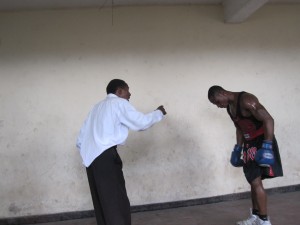Goma, Nord-Kivu March 1st 2011
 Jab-jab, droit! Jab-jab, droit! It is the day after a failed coup in the DRC but no one is paying much attention, and not here this morning either, where our boxing drills have been going on for half an hour. They are led by the top student, Cédric, who is also Congo’s national feather weight champion and though probably 19 or 20, is completely authoritative in leading the class. When our teacher, Kibomango, strides in the atmosphere is brisk and businesslike. His national title fight is a week tomorrow and the training is on in earnest. He takes little notice of us and goes straight to sparring with the punch bag.
Jab-jab, droit! Jab-jab, droit! It is the day after a failed coup in the DRC but no one is paying much attention, and not here this morning either, where our boxing drills have been going on for half an hour. They are led by the top student, Cédric, who is also Congo’s national feather weight champion and though probably 19 or 20, is completely authoritative in leading the class. When our teacher, Kibomango, strides in the atmosphere is brisk and businesslike. His national title fight is a week tomorrow and the training is on in earnest. He takes little notice of us and goes straight to sparring with the punch bag.
Shortly later an older, tough looking, rail thin man arrives wearing a worn suit, shinny in the seat and knees and with scuffed-up leather shoes. This turns out to be the trainer and as he passes by this man’s intensity and self-possession is conspicuous. He has a thin, drawn face and hard eyes—the face of a former boxer who has seen it all. He is a member of the provincial boxing federation and works for the Goma airport police detachment, the latter an incredibly powerful position; every plane cargo, every person, every business deal in the province must pass before this man. He ignores us completely and sets to the training regime with Kibomango. My teacher has a teacher.
The relationship between a boxer and his trainer balances authority and control and I am reminded of the old hard-bitten coach opposite Sylvester Stallone in the Rocky movies. The coach speaks in short brisk bursts, practically barks, gesturing with his arms and even interrupting Kibomango with a slap if he sees something he doesn’t like. This is how someone learns at the feet of a great teacher—through concentration and complete submission. I feel like I’m watching Luke Skywalker and Obi–Wan Kenobi in a Jedi Knight lesson.
It is hard not to be spell-bound by this but we carry on with our own drills and I’m grateful that Kibomango’s training is there to distract the attention of the large group of bystanders who have gathered to watch. On the first day back after 2 weeks out due to typhoid I’m barely keeping up with the class who have moved on to a new set of more complicated drills: two left jabs, a right, jump back, dip and feint right, deliver an upper cut and a hook, and then the same on the left, all the while “dance boxing”, the light footwork that involves jumping back and forth from your left foot to your right and which you are supposed to maintain while moving around the ring the whole time during a bout. When done properly by someone like Cédric or Kibomango it is beautiful to watch, almost balletic.
After an hour of this, we stop and the gloves are brought out to prepare for the morning’s bouts. We’ve been doing this periodically among ourselves but this time it is for real. Kibomango is going to do 3 rounds each with the boxers in our group as a simulated fight training session. Cédric is up first and the fight looks genuine, although both are holding back power and pulling the punches; the point is to find a break in the opponent’s defenses and both are working hard to do exactly that: circling each other, before charging and delivering rapid fire blows, with blocks, dips and pulls backs. When the final round ends and Cédric comes out his nose is bleeding.
I dread the prospect that I might be up next with Kibomango, but instead am matched with a young boxer named, appropriately enough, Saddam. When I take a good punch to the face in one of the rounds I’m reminded of exactly how my inglorious boxing career at Cambridge University ended. We trained hard all during that cold rainy English Autumn, learned the basics, sparred with each other, became confident, thought we’d made progress. When the first real fight came it was against the Essex County British Navy Reserve—young men drawn from the rough side of east London. Nearly all the fights were stopped in the opening seconds they were so lopsided.
